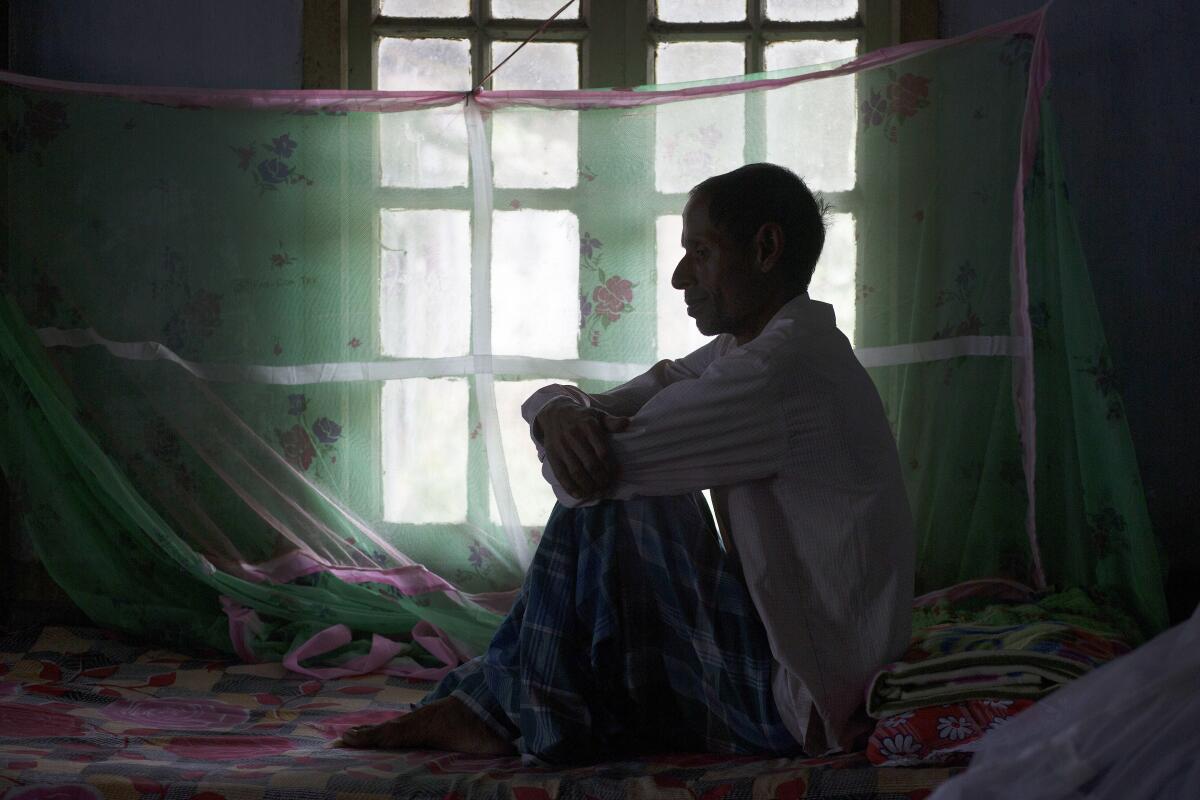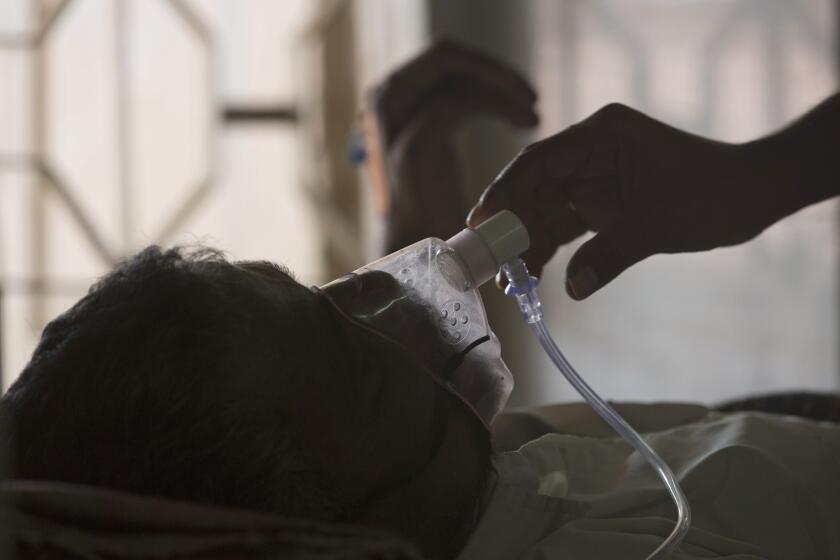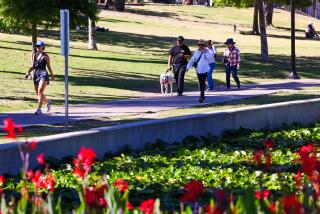Tuberculosis cases rising in California, and state officials are sounding the alarm

- Share via
Tuberculosis cases are rising again in California, and health officials are urging those at higher risk, as well as doctors, to be alert for the disease, which can lurk in people’s bodies for years before becoming potentially deadly.
The number of tuberculosis cases in 2023 rose by 15% in California compared with the previous year, the state Department of Public Health said. That’s the highest year-over-year increase since 1989, when it was tied to people co-infected with HIV.
There were 2,113 cases across California last year; that’s about the same amount reported in 2019, before the COVID-19 pandemic. Seniors 65 and older had the highest percentage increase in cases from 2022 to 2023.
Tuberculosis rates also are rising nationally, up 16% in 2023 compared with the previous year, the U.S. Centers for Disease Control and Prevention said Thursday. The 9,615 cases provisionally reported last year were the highest since 2013 and were 8% higher than the tally of 8,895 cases reported in 2019.
Those at major risk for tuberculosis include people who have lived outside the U.S. where the TB rate is high, including most nations in Asia, the Middle East, Africa, Eastern Europe and Latin America.
Nationally in 2023, TB cases increased among all age groups and those born inside or outside the U.S., the CDC said.
Caused by bacteria Mycobacterium tuberculosis, tuberculosis disease is spread through the air. Unlike COVID-19 — in which infection can occur in minutes — a person would typically need to be exposed for hours to inhale enough TB bacteria to get infected, said Dr. Julie Higashi, director of the L.A. County tuberculosis control program.
Most active cases in California are from people with latent TB who picked up the bacteria decades ago but weren’t contagious or showing symptoms. “Then something happens. Either they age ... and their immune system actually becomes weaker ... and then they progress” to acute TB, Higashi said.
On the flip side, an estimated 18% of TB cases in L.A. County occur from recent transmission.
California officials said that 13% of people with tuberculosis died in 2020. That’s up from 8% in 2010. Generally, more than 200 Californians die from tuberculosis every year, state officials say.
A rarity in the U.S., tuberculosis can go undiagnosed for years while patients suffer.
TB has afflicted humanity since before the dawn of recorded history, and at one point in the 17th and 18th centuries, caused one-quarter of all deaths in Europe.
It was only on March 24, 1882 — 142 years ago Sunday — that a scientist announced the discovery of the bacteria that causes TB. (Decades earlier, TB was thought to be hereditary, and in New England, inspired “vampire panics” because people thought the first family member to die of TB would come back as a vampire to infect the rest of them, according to the CDC.)
By the start of the 20th century, tuberculosis was one of the leading causes of death in the United States.
Governments in the early part of the last century began making serious progress in preventing infectious diseases. According to the CDC, housing improvements reduced overcrowding — a risk factor for TB spread — and programs were launched to control TB. By 1940, the TB death rate was one-fourth what it had been at the turn of the century. Further progress was made with the discovery of TB treatments in the middle of the 20th century.
TB cases have generally been declining in California since the early 1990s but continue to take a significant toll, a tragedy given the disease is detectable and treatable.
“Not only can you treat the active disease, you can also treat the latent disease, which is much easier to treat — fewer drugs, much shorter time — and then prevent that progression to the active form of disease,” Higashi said.
The CDC estimates 13 million people in the U.S. have a latent tuberculosis infection — meaning they have no symptoms and can’t spread the bacteria. Without treatment, 5% to 10% will develop active disease that can turn contagious and potentially deadly later in life.
Outbreaks can happen locally. In Contra Costa County last year, 11 confirmed cases were linked to staff and customers of the California Grand Casino in Pacheco. At least 10 cases were genetically linked.
According to the most recent data, California counties with the highest per capita rates of tuberculosis are generally along populous coastal areas. In Southern California, those with the highest rates were Los Angeles, San Diego, Orange and Imperial counties. In Northern California, they were Santa Clara, Alameda, Sacramento, Contra Costa, San Francisco, San Mateo, San Joaquin, Solano, Monterey and Napa counties.
Contra Costa County Health recommends Pacheco casino patrons test for tuberculosis after confirmed cases linked the disease to staff and customers. What you need to know
Officials noticed a substantial drop in TB cases in 2020, tied to stay-at-home orders and reduced travel during the early phase of the pandemic. Since then, case rates have increased 4% to 5% each year before jumping by 15% in 2023.
The rise in TB cases in Orange County, California’s third most populous, has been especially pronounced, jumping 20% between 2022 and 2023; in L.A. County, cases rose by about 4% over the same time, according to local data.
According to state data, Orange County’s per capita TB case rate is 10% higher than L.A. County’s.
“We have a lot of people who travel, and also have family members who come from other countries with higher rates of TB,” Dr. Regina Chinsio-Kwong, Orange County’s health officer, said.
Cities in Orange County with TB case rates higher than the overall county rate are Laguna Hills, Westminster, Garden Grove, Buena Park, Santa Ana, Fountain Valley, Anaheim, Costa Mesa and Lake Forest, according to county data.
Those at highest risk in Orange County are people born outside the U.S., Asian Americans, males, and seniors age 65 and up. Having diabetes, HIV or smoking cigarettes increases the risk of having latent TB develop into full-blown TB, Chinsio-Kwong said.
A surge in tuberculosis, partly fueled by global conflicts, is now killing more people worldwide than COVID-19 or AIDS.
With “latent TB, when someone’s immune system is nice and strong, you have no symptoms, it doesn’t affect your organs,” Chinsio-Kwong said. “But it can develop into active TB when you’re immunosuppressed. So that’s where diabetes, smoking or any infectious disease, like HIV, can really put you at higher risk of developing an active TB case.”
Routine testing for higher-risk people, such as healthcare workers, can be helpful. Chinsio-Kwong said she was diagnosed with a case of latent TB earlier in her career, prompting her to take a nine-month regimen of treatment.
“If we can appropriately treat all the latent TB cases, we can really reduce the number of active TB cases,” she said. “The hope is that you detect latent TB before you develop symptoms — because by the time you have symptoms, you’re an active TB case, spreading your germs and possibly even spreading the infection to others.”
In Los Angeles County, 91% of tuberculosis cases were among Latino or Asian American residents. The top seven countries of birth of people with TB were Mexico, the Philippines, Guatemala, China, Vietnam, El Salvador and South Korea.
Areas with the highest tuberculosis case rates in regions monitored by the L.A. County Department of Public Health were in central L.A., which the agency defines as including downtown, Echo Park, Silver Lake and the Hollywood Hills; South L.A.; and an area of the western San Gabriel Valley that includes Alhambra, Monterey Park and San Gabriel.
Other areas with TB rates above the L.A. County average include the neighborhoods covering Hollywood, northeast L.A., El Monte, East L.A., Inglewood, Torrance and Bellflower.
The World Health Organization says the number of people infected with tuberculosis, including the kind resistant to drugs, rose globally for the first time in years in 2021.
Of the regions with L.A. County’s highest TB cases, those with the highest mortality rates were in the Alhambra-Monterey Park-San Gabriel area, where 15.4% of tuberculosis cases resulted in death; and Central L.A., where 20.5% of cases resulted in death.
A large problem with TB is that it’s possible for doctors to miss a diagnosis, as TB is relatively rare. The California Department of Public Health last month urged healthcare providers to consider tuberculosis as a potential cause of respiratory illness among higher-risk people.
There are situations in which doctors can misdiagnose people with TB. While the disease typically grows in the lungs — leading to symptoms such as chronic cough, chest pain and coughing up blood — the bacteria also can grow in other areas of the body, including the gastrointestinal tract or the nervous system, and doctors might miss a TB diagnosis in that atypical presentation.
Instances of misdiagnosed TB cases previously documented by The Times include a San Fernando Valley businessman, who was raised in Chile and suffered for 11 years until a TB diagnosis was made; and a Shanghai-born UC Berkeley Mandarin lecturer who was misdiagnosed with Crohn’s disease and given a steroid to suppress her immune system, allowing her TB to spread. It was only when she lay gravely ill in a hospital that a doctor seriously considered TB.
One prominent misdiagnosis occurred in 2004, when Dr. Claudia Lacson — pregnant with her first child — fell into a coma in Georgia after complaining of severe headaches and a persistent fever. Doctors initially suspected bacterial meningitis, but by the time doctors began TB treatment, it was too late, and she died at age 38, weeks after giving birth to a daughter, who also did not survive.
“What we want providers to know is that when any individual comes to them presenting with respiratory symptoms, they need to start thinking about is: Is this potentially a person who is at risk of having TB?” Chinsio-Kwong said. “Even if you weren’t born [in] another country, if you’re in close proximity to those who are coming from out of the United States, there’s a risk.”
More to Read
Sign up for Essential California
The most important California stories and recommendations in your inbox every morning.
You may occasionally receive promotional content from the Los Angeles Times.













